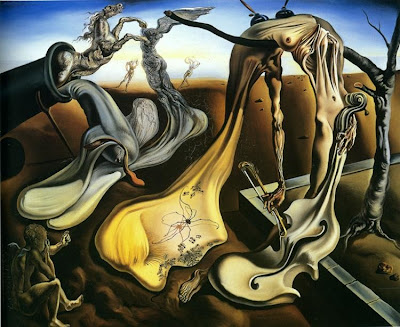The Artist:
Salvador Felipe Jacinto Dali I Domenech was born May 11, 1904 in the small town of
Figueres, Spain. When he was a young boy Dali spent his years in Figueres and
at the family's summer home in the coastal fishing village of Cadaques where his
parents built his first studio.
Dali attended the San Fernando Academy of Fine Arts in Madrid.
Recognition of his talent came
early with his first one-man show in Barcelona in 1925. As an adult, he
made his home with his wife Gala in nearby Port Lligat, as it reflects in many
of his paintings the great love he had for this area of Spain. Dali and Gala
escaped from Europe during World War II, spending 1940-48 in the United States.
These were very important years for the artist. The Museum of Modern Art in New
York gave Dali his first major retrospective exhibit in 1941. This was followed
in 1942 by the publication of Dali's autobiography, The Secret Life of Salvador
Dali. As an artist, he was not
limited to a particular style or media. The body of his work, from early
impressionist paintings through his transitional surrealist works, and into his
classical period, reveals a constant growth as a evolving artist. Dali worked
in all media, leaving behind a wealth of oils, watercolors, drawings, graphics,
and sculptures, films, photographs, performance pieces, jewels and objects of
all descriptions. Dali was known as a great craftsman his works as creative
artist set the standard for the art of the twentieth century.
The Work:
This particular oil on canvas painting is between the transition of Dali's surrealism and classicism phases. This piece was made as a reference of World War II. Each piece in this painting symbolizes an event that took place during that war. In the left hand corner there is a cannon propped up by a crutch which is suppose to symbolize death and war. Out of the opening of the cannon there are two objects including a fluid biplane and a white horse. The horse is displaying a sense of power, speed, and control. There is also a winged victory figure, Dali described as,"victory born of a broken wing." Salvador felt that the use of air power would be the decisive element of the war, the very key to victory itself. History has shown that this is at least partially true (www.moodbook.com). Near the center of the painting there is a figure, which Dali calls a 'soft self-portrait."The self-portrait that Dali is referring to is a decaying body slumped over a dead tree, there are inkwells propped on it, and it's holding a violin. At the time there were signing of treaties taking place and the inkwells symbolize that. There is also a cupid figure in this painting that sees the destruction in front of him. Last but not least, there is a daddy longlegs spider in the exact center of the painting which is a French symbol for hope so Dali wanted to express the fact that through all the turmoil you can still overcome.
This particular oil on canvas painting is between the transition of Dali's surrealism and classicism phases. This piece was made as a reference of World War II. Each piece in this painting symbolizes an event that took place during that war. In the left hand corner there is a cannon propped up by a crutch which is suppose to symbolize death and war. Out of the opening of the cannon there are two objects including a fluid biplane and a white horse. The horse is displaying a sense of power, speed, and control. There is also a winged victory figure, Dali described as,"victory born of a broken wing." Salvador felt that the use of air power would be the decisive element of the war, the very key to victory itself. History has shown that this is at least partially true (www.moodbook.com). Near the center of the painting there is a figure, which Dali calls a 'soft self-portrait."The self-portrait that Dali is referring to is a decaying body slumped over a dead tree, there are inkwells propped on it, and it's holding a violin. At the time there were signing of treaties taking place and the inkwells symbolize that. There is also a cupid figure in this painting that sees the destruction in front of him. Last but not least, there is a daddy longlegs spider in the exact center of the painting which is a French symbol for hope so Dali wanted to express the fact that through all the turmoil you can still overcome.
My Reaction:
I interpreted this painting a little bit differently because I did not see the daddy longlegs spider as being the subject. The decaying female body is what stood out to me. This body is faceless but I can identify it as a female because of the breasts that are slumped over the tree. I see what appears to be a vagina covered by the handle of a violin. It looks like the daddy longlegs is resting on a piece of the self-portrait and with that being said I conclude that through it all the female symbolizes hope. At this time, the women were finally allowed to step up to the plate and service their country by working in the military or obtaining industrial jobs and no longer being domestic.
Janson, H. W., and H. W. Janson. Janson's History of Art: The Western Tradition. Upper Saddle River, NJ: Pearson Prentice Hall, 2007. Print.
Neret, Gilles, and Robert Descharnes. Salvador Dali 2v. 2007. Print.
"Salvador Dali." . Surreal Years. Art, Paintings, and Works. Web. 05 Mar. 2012. <http://www.moodbook.com/history/modernism/salvador-dali-surreal.html>.



